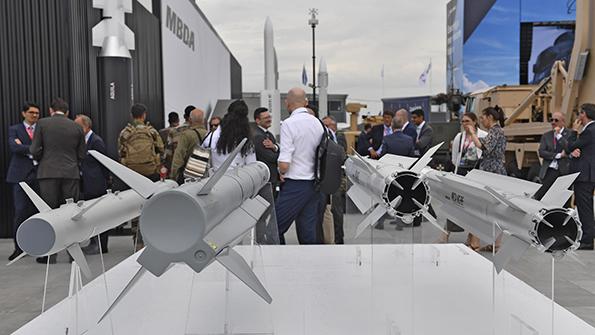
MBDA’s Paris Air Show display reflected growing European interest in air defense.
Two major European air defense initiatives were center stage at the Paris Air Show, and a new French-led effort kicked off the show with a focus on homegrown systems.
French President Emmanuel Macron chaired a meeting on June 19 to announce the plan to convince European allies to buy European-made systems, including a new, modest agreement for Belgium, Cyprus, Estonia and Hungary to buy MBDA Mistral short-range air defenses. The French project appears to be in direct competition with Germany’s European Sky Shield Initiative (ESSI), which was joined by 17 European nations to improve NATO’s air defenses quickly—in part by buying U.S.-made equipment such as the Patriot system.
- First announcement is for short-range air defenses
- Raytheon angling for European market with new radar
Macron says Russia’s full-scale invasion of Ukraine shows the need for improved air defenses, and he wants to bolster France’s own industrial base and focus on European sovereignty by buying systems developed on the continent. This is a strategic decision the nations need to make, as opposed to buying extensively off the shelf now, which would not be effective, he said.
“What comes to us from non-European third parties is obviously less manageable, subject to timetables, queues, prioritizations, sometimes authorizations from third countries,” Macron noted, adding that American companies would deliver at their own dictated pace based on other priorities.
“It is really Europe that protects Europe,” he said.
Macron’s push will include encouraging the purchase of such systems as additional MBDA Aster SAMP/T systems as opposed to U.S.-made Patriots. The latter have been disclosed as part of Germany’s ESSI along with the Diehl Defense medium-range IRIS-T surface-launched missile and the Rheinmetall/Oerlikon Skyranger.
Shortly before the air show, Germany also announced its intent to buy six additional IRIS-T systems along with initial funding for its Israel Aerospace Industries Arrow anti-ballistic missile acquisition. Other nations recently announced new efforts as well. Slovakia in late June outlined a four-stage program to acquire new air defenses after sending much of its equipment to Ukraine. In May, Estonia and Latvia both announced selections of the IRIS-T for a medium-range need, with deliveries expected in 2024-25.
American air defense providers pitched their systems for the new initiatives, too. Raytheon showcased its new GhostEye MR radar for medium-range air defenses, specifically tailored for the National Advanced Surface-to-Air Missile System that it produces with Norway’s Kongsberg. The radar takes a version of the gallium-nitride active, electronically scanned array radar from the U.S. Army’s Lower-Tier Air and Missile Defense Sensor and places it on a rotator. This gives it a similar range to that of the Patriot, allowing it to use the “full capability” of the AIM-120 Advanced Medium-Range Air-to-Air Missile, Tom Laliberty, Raytheon’s president of land and air defense systems, tells Aviation Week.
Macron’s announcement is part of a broader push for independence from American-made weapons. Related to that trend, the U.S. presence in Le Bourget was much more muted than at previous iterations of the Paris Air Show. While the major U.S. primes had large chalets and displays, fewer Defense Department and other U.S. agency officials attended, and those who did avoided public events. The only notable public event involving American government officials was a brief press conference with members of a congressional delegation that announced it was meeting with Macron to urge the French government to provide more aid to Ukraine.
“While we came here to make certain that Europe and others contribute more to the cause for Ukraine—that they increase their capabilities and commitment to Ukraine and European countries across this continent—I also discovered a role that we’re playing is reassuring those Europeans that the United States is assisting Ukraine for the long haul,” said Sen. Jerry Moran (R-Kan.).
The desire to rely less on U.S.-developed capabilities extends beyond air defenses, as illustrated by Airbus’ highlighting of its work to develop the “combat cloud” data connectivity for the Future Combat Air System. Jean-Brice Dumont, the company’s executive vice president for military aircraft, said the current reliance on the Link 16 NATO standard is limiting, and European nations need to agree on their own system. Dumont said this will be a mix of technology and standardization.
“Fundamentally, we have to be interoperable with the U.S. platforms, but the intention of Europe is to have this autonomy,” he said.
